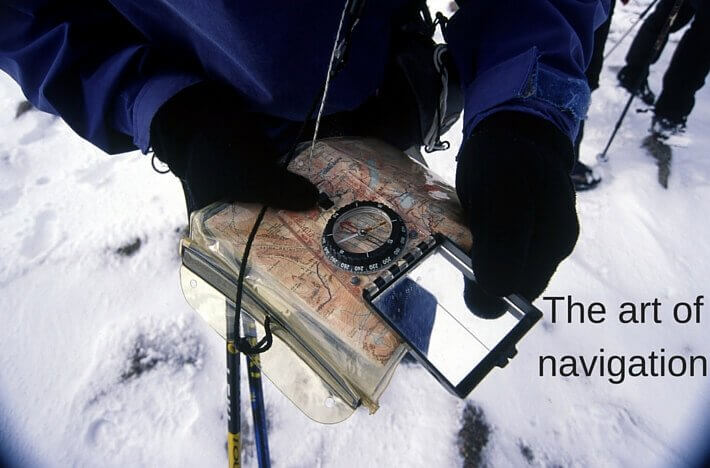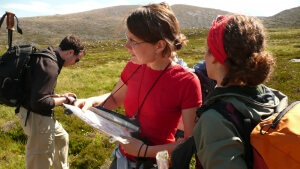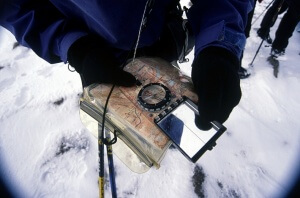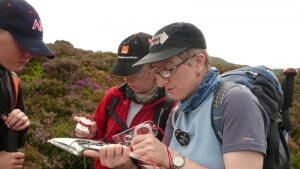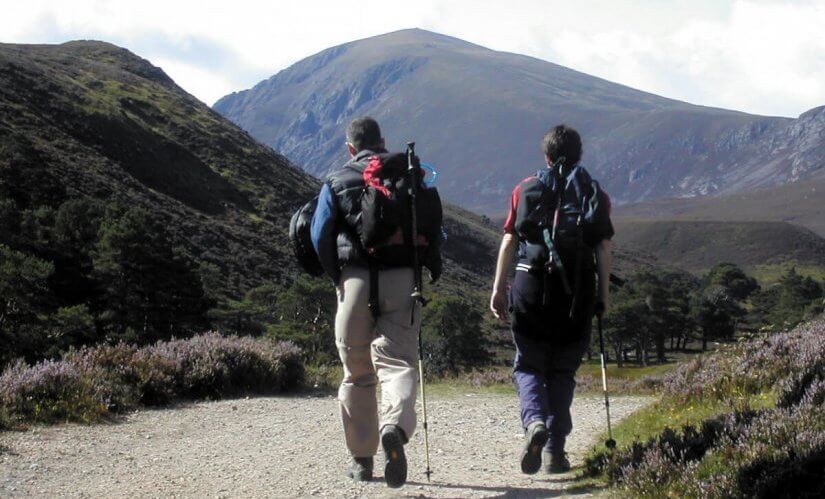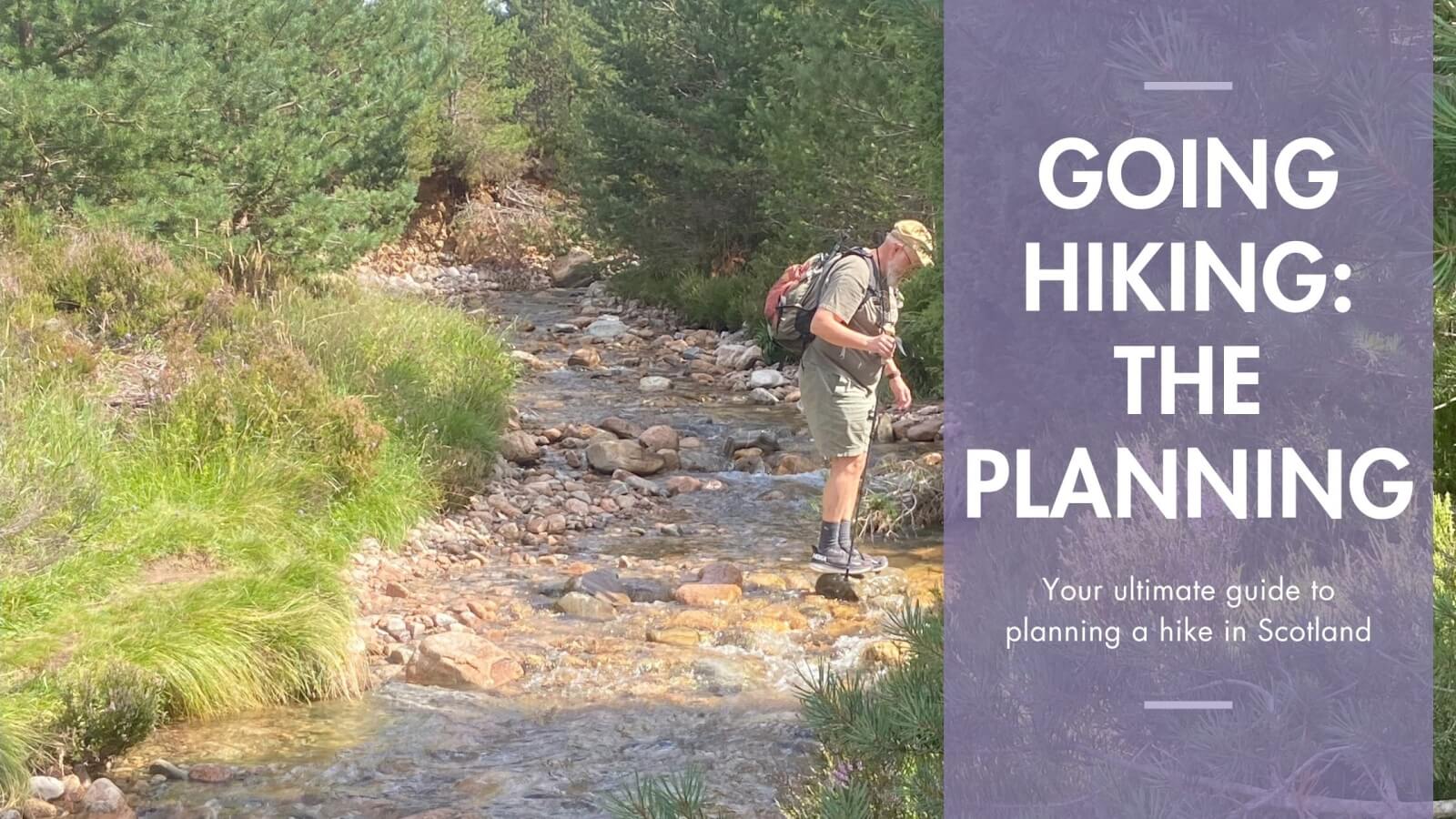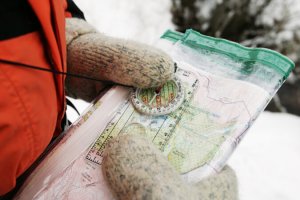
Dachstein mitts don’t necessarily mean that you won’t be able to use a compass or to navigate, as shown by our director Andy Bateman
Managing Mountain Navigation:
you will make errors – how to deal with your errors?
Autumn and early winter is the time when the contrast between warm seas and cold air is at its greatest. This has the effect of injecting even more energy into our already turbulent skies. Then the weather at this time is even more changeable. In addition, the ground is often covered by snow. The snow covered ground merges with the cloud. Flat light conditions as well will make navigation even more difficult as everything you see appears to be the same colour. This doesn’t mean that you need to hand up the mountain boots until Spring. It might mean that you should consider brushing up on your navigation skills so you can deal with the shorter days (flat light) and the potential for more inclement weather (autumn/winter).
Winter navigation has been described as a bit of a “black art”. This isn’t a particularly helpful phase for anyone trying to get their head around the subject. Dealing with even the worst of winter white-outs isn’t rocket science. It does require the right approach, mindset and plenty of practice.
Navigation accuracy operates on two levels:
- accuracy in a particular skill or technique
- “overriding error management”.
There are so many variables in the mountain environment that it is important not to overlook “error management”. Looking back to when I did my summer ML many moons ago I had too much focus on the former and didn’t really appreciate the latter.
What is error management?
- using tactical ways to keep error below certain levels,
- employing a number of techniques simultaneously.
- employing techniques that either accommodate or negate its effect
- relating everything to your contour interpretation
1. A tactical approach to managing mountain navigation
Logically if we get our distance and direction right we will get to our objective. The most common way people get lost in the mountains is when they allow an error in their distance and direction to get out of control. You must never allow an error in your distance and direction estimate to become greater than the range of visibility. A 10 % error in distance or direction over 500m will be a quarter of that over 2 km in real terms.
Keeping your navigational legs to below 1 km in winter should be one of your key aims but to do this requires more waymarking points/features. For this you’re invariably looking to your contour interpretation skills. On many occasion I have heard it be said “the Cairngorm Plateau is featureless”. It isn’t, it’s just that the features are often a lot more subtle. You need to be a skilled map reader to pick them out.
2. Don’t rely on just 1 or 2 techniques
Don’t “put all your eggs in one basket”. Accuracy in one particular technique or skill is good but don’t let this tempt you into relying on one or two techniques. By employing a number of skills simultaneously they should confirm each other.
An additional technique that I and mountain navigation course students have found very useful is to use a very comprehensive and detailed timing & pacing chart (see extract below). In the extreme left hand column you have your double pace rate (dp) with the distance running along the top. Working on the basis of + or – 5 double paces per 100m is within the realm of acceptable error, it gives you the acceptable error for a particular distance.
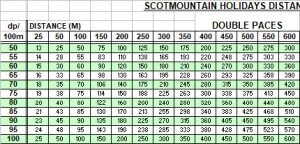
Pacing chart developed by Andy Bateman to keep navigational error when using timing and pacing to a minimum
For example, if you estimated you’re going to do 595 dp’s over for 850m (dp rate of 70) and you end up doing 616, a quick reference to the chart shows you that this figure lies neatly between what you estimated and the next rate up of 638 dp ie within the acceptable range of error. To be 21 dp out over 150 would be well off the mark. This information can then be used in conjunction to what other skills and techniques are indicating about your position.
3. Techniques that negate error
With all the tactical techniques of aiming off, attach points and collection features, at some stage in their execution they all correct the error. If applied appropriately they can be used to great effect and can improve you overall accuracy and efficiency
4. Contour Interpretation and Conclusion
Contour interpretation and having that 3D image of terrain in your mind is the focal point of mountain navigation skill. It is what the information fed back from all the other skills and techniques relates to. In the worst conditions you contour interpretation skills it may offer the first and only indication that your drifting off your bearing.
To try any of these techniques in practice book one of our navigation courses or a 5 day winter skills course.


